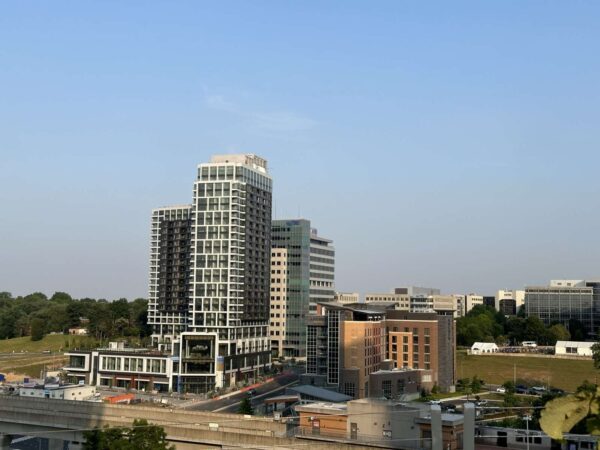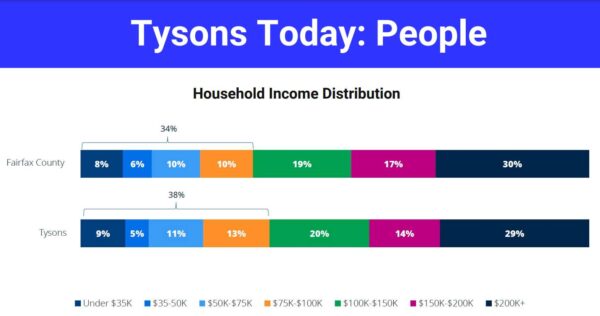

After introducing itself earlier this year with a website update and some cherry blossom-related events, the Tysons Community Alliance is now digging into the area’s strengths, needs and what needs to be done to set it up for future success.
Picking up where the now-defunct Tysons Partnership left off, the nonprofit community improvement organization launched a strategic planning effort for Tysons this week by convening a series of work groups that will focus on different topics, such as residential development, transportation and parks.
The strategic plan will serve as an update on the current state of Tysons and a guide to implementing Fairfax County’s Tysons Comprehensive Plan, TCA Board of Directors Chair Josh White told the Board of Supervisors at an economic initiatives committee meeting on June 13.
“One of the key purposes of the alliance is to help catalyze the continuing transformation of Tysons into a walkable, urban center and community,” White said. “…It is our intent to facilitate a community engagement process with a lens focused on diversity, inclusion, equity, and sustainability, which will chart a future direction for Tysons and help shape an action agenda.”
As part of the planning process, the TCA is conducting a conditions assessment and market study that will provide data on economic trends and gaps to support the future strategic plan as well as a new Tysons database.
Acting TCA CEO Richard Bradley — who will soon give way to the first permanent CEO, Katie Cristol — described the database as a more comprehensive version of the Tysons Tracker that the county launched in 2021, sharing information about all things Tysons, from population data to office usage.
Underway since April, the market study is slated to be finished around mid-July, per the presentation. But statistics shared by TCA leaders reinforced the oft-repeated refrain that Tysons is the county’s “economic engine,” while also exposing potential challenges to its ambitions.
Despite encompassing just 1% of the county’s total land area, Tysons accounts for 17% of its jobs, 10% of all retail revenue and 8% of tax revenues, White touted.
As reported to the Fairfax County Planning Commission in January, about 30,124 people now live in Tysons — a 96% increase from 2010, when the comprehensive plan was adopted. Like the county as a whole, the area has a “minority-majority” population, and while 29% of residents earn salaries of $200,000 or more, 38% have incomes of $100,000 or under — a larger percentage than in the overall county.

Some supervisors expressed surprise at those numbers, noting that affordable housing will be critical for maintaining the area’s “economic diversity.”
“I think we all hear Tysons or we hear McLean or we hear Oakton or we hear Falls Church or Alexandria, and we have these preconceived notions of who lives there and what does the community look like and what do the businesses look like,” Providence District Supervisor Dalia Palchik said.
The TCA also shared positive news for the retail market, where visits have bounced back to 96% of pre-pandemic 2019 levels. Sales in Tysons represent 10% of the county’s total retail revenue, with about 65% of spending coming from non-residents.
On the flip side, the office market continues to struggle, though Tysons and Fairfax County are better off right now than the rest of the D.C. region, according to Bradley.
Despite a 2021 market study that projected a need for at least 1.9 million square feet of new office space over the next decade, existing vacancies have climbed to 20% from around 15% a few years ago, Bradley said. He noted that office visits have returned to about 78% of what it was back in 2019, suggesting that more employers with offices are bringing workers back.
The sustained vacancies have led to an uptick in developers repurposing offices for residential uses. The McLean Citizens Association recently said it counted nine such proposals in Tysons and McLean, raising concerns about possible negative impacts to funding for public services in a June 7 letter to Board of Supervisors Chairman Jeff McKay.
“We’ve had some vacancy issues…for quite a while in certain pockets of Tysons,” McKay said. “We don’t want those vacant and, in most cases, antiquated, more suburban-scaled office components to be hinder us from some of the other redevelopment and some of the connecting-of-the-sidewalks piece.”
A recent TCA analysis identified 4.62 miles of gaps in Tysons’ 24-mile sidewalk network, which has been built in large part by developers.
White said the strategic plan will offer more insight into how Tysons can strike the right balance between responding to current trends and preparing for the future by combining a data-driven approach with the firsthand knowledge of the residents, employers, developers and other community members participating in the work groups.
The effort will expand beyond the work groups next month, when TCA anticipates launching surveys on residential development, offices, retail, transportation, parks, and hospitality. The organization hopes to publish a full report with the plan by late fall.
Angela Woolsey is the site editor for FFXnow. A graduate of George Mason University, she worked as a general assignment reporter for the Fairfax County Times before joining Local News Now as the Tysons Reporter editor in 2020.